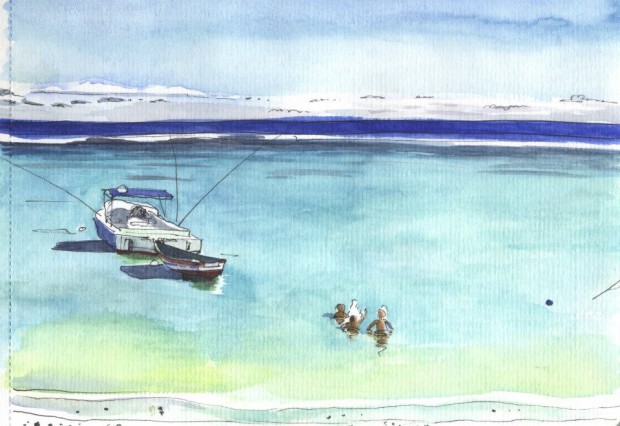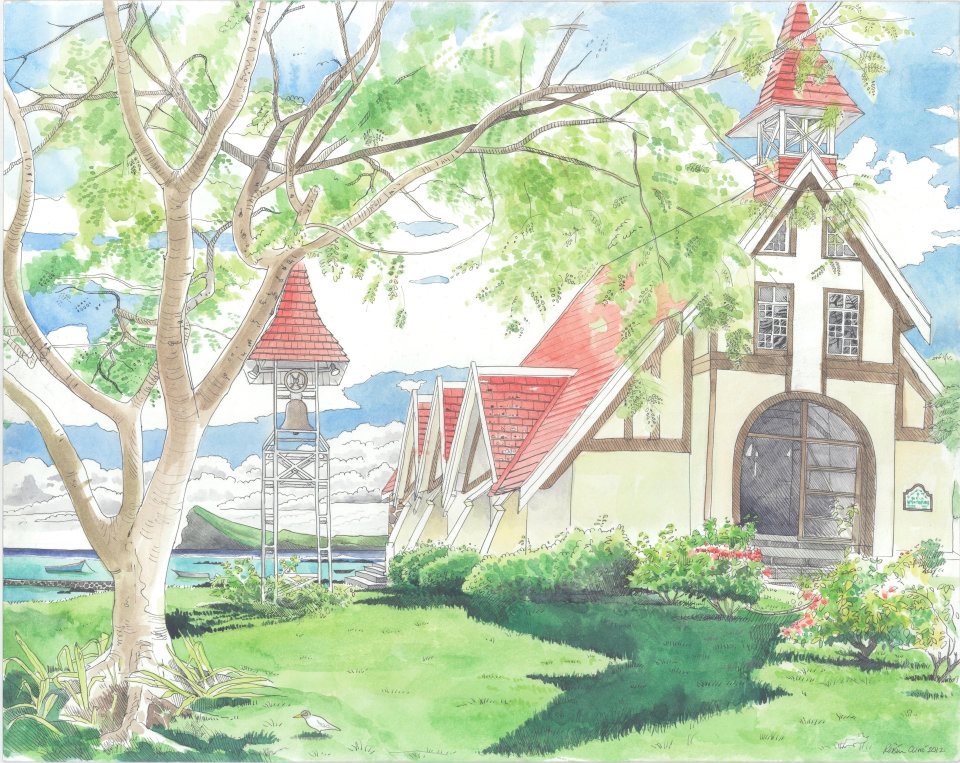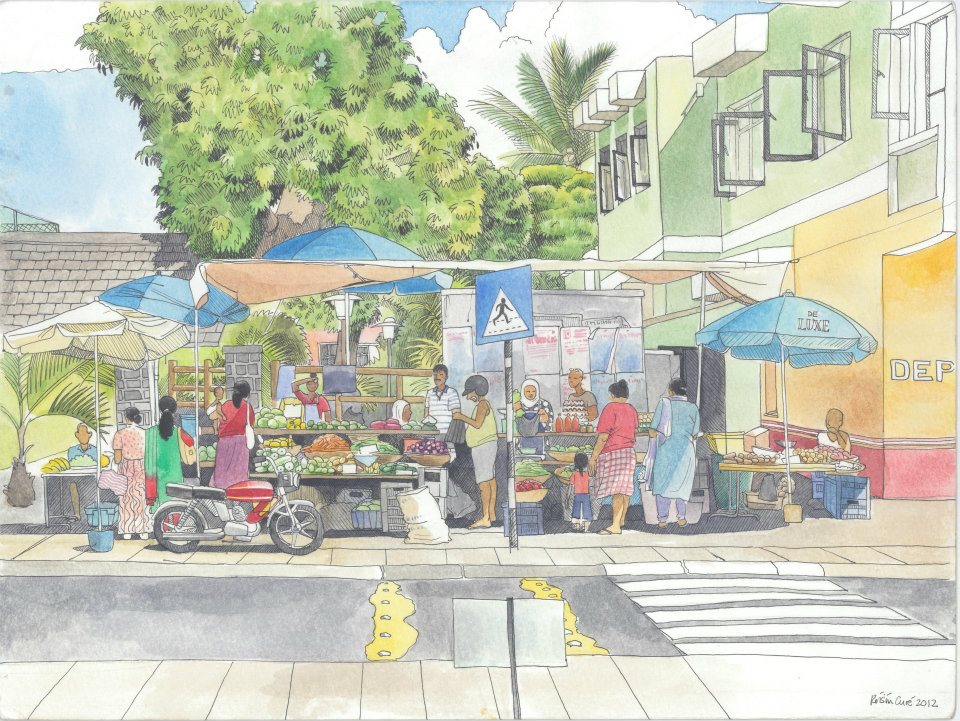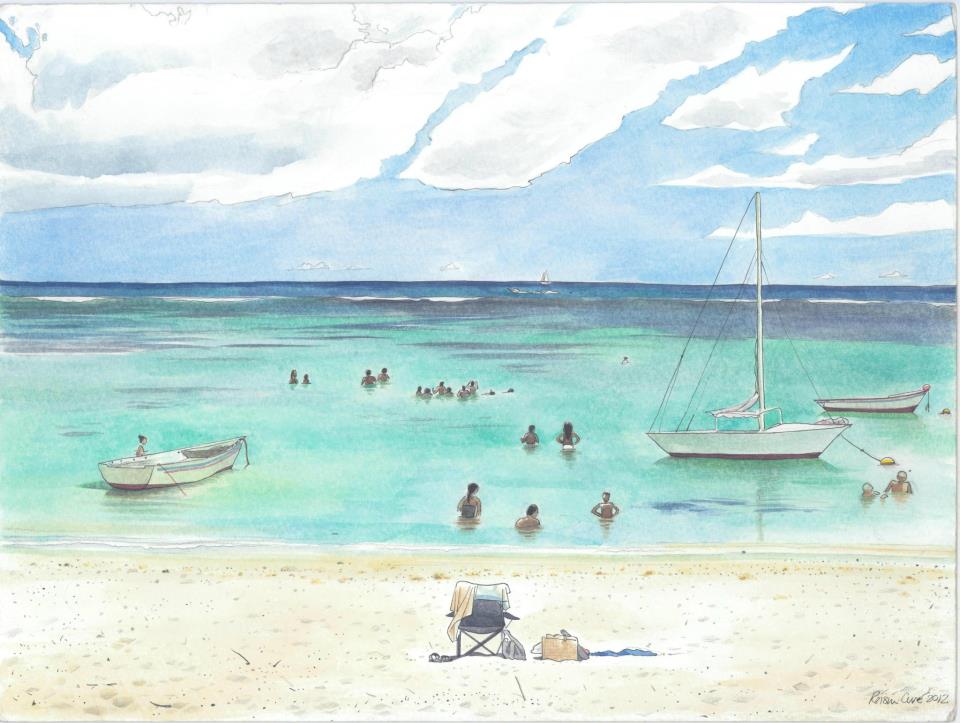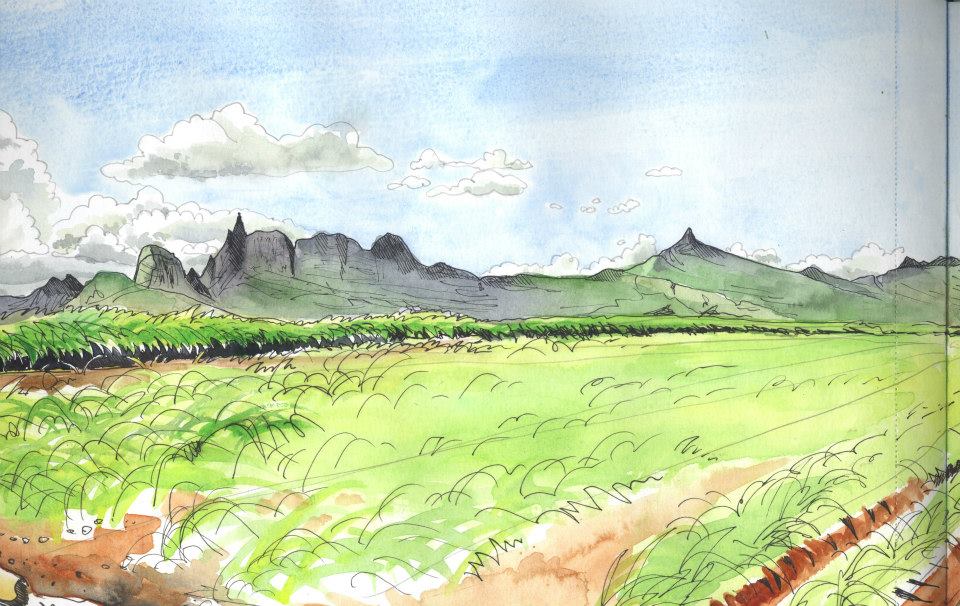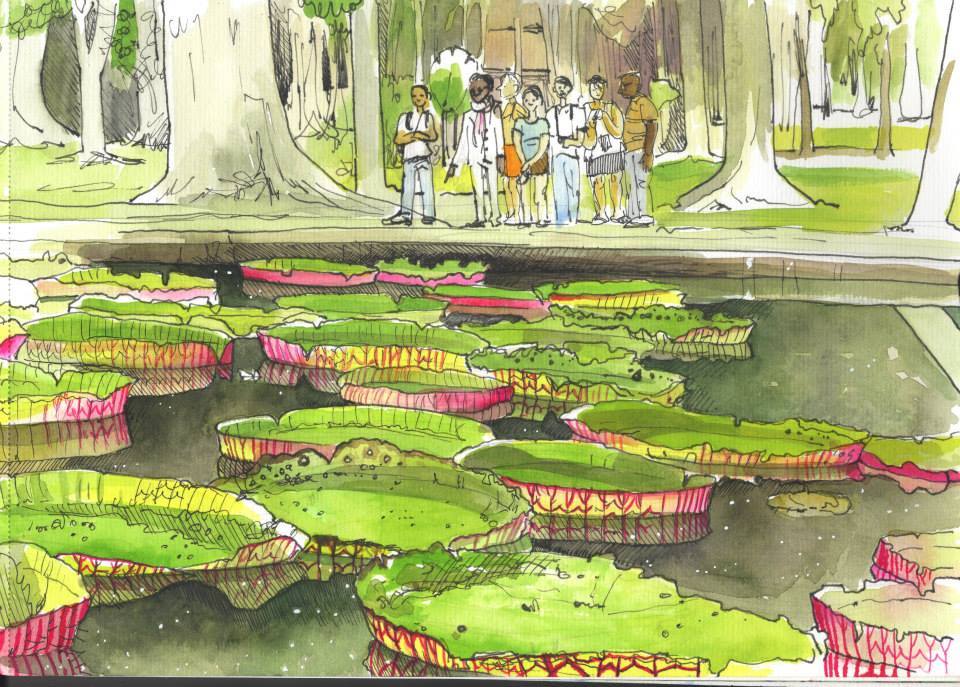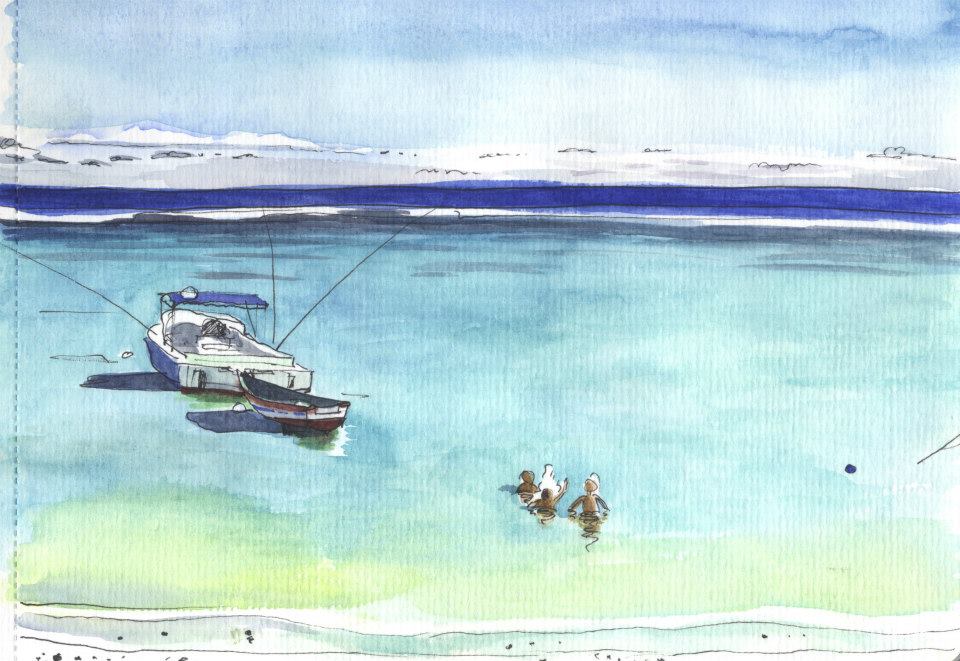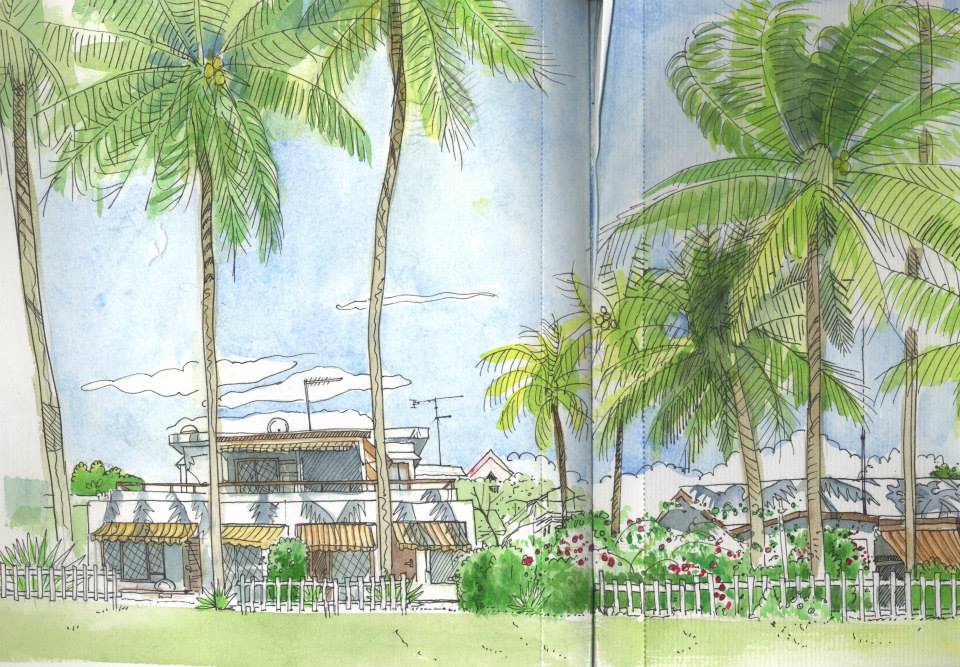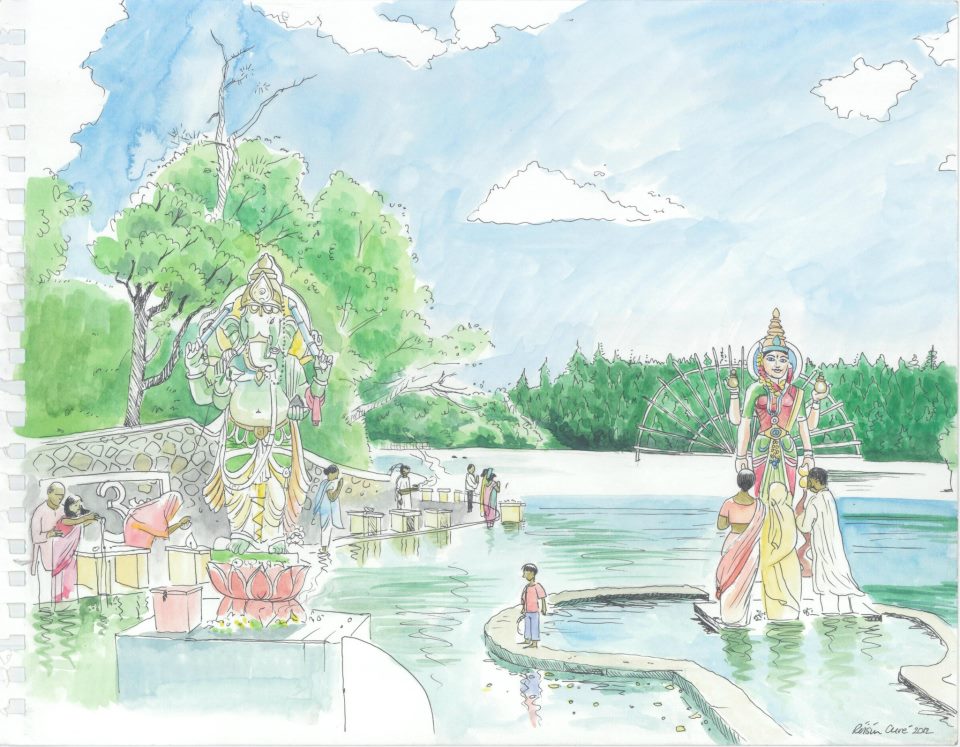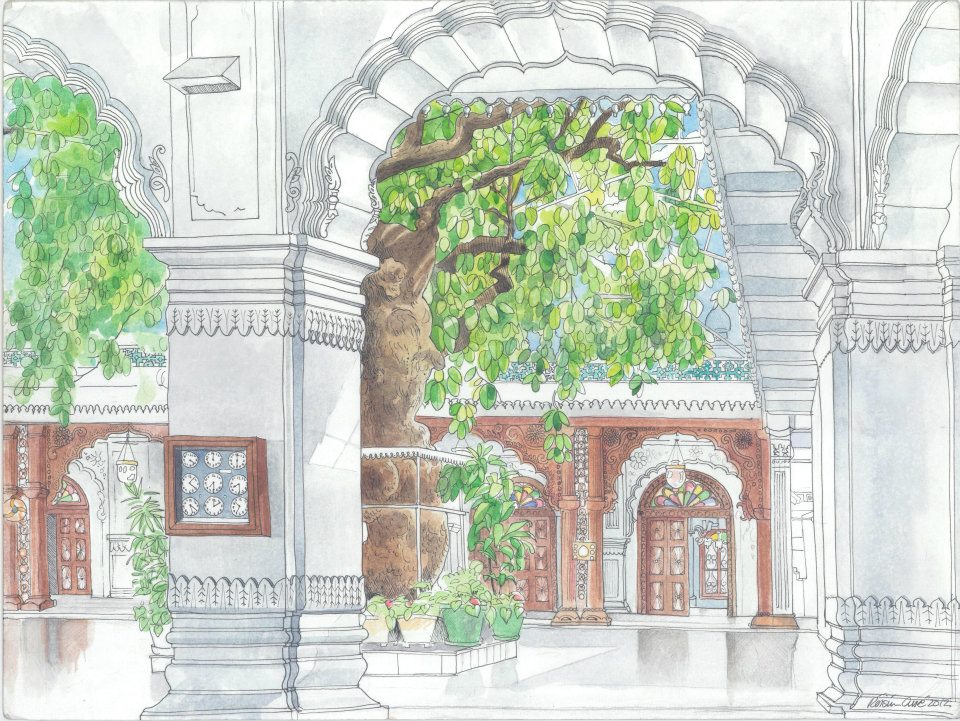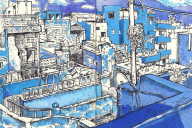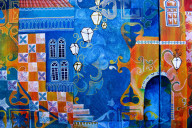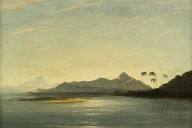When you think of Mauritius, do you think of sun-drenched beaches and bright blue waters? I sure do. Thankfully, that image isn’t far from reality, as Roisin Cure demonstrates with her beautiful paintings of the island. Not only do her pieces look wonderful, but her stories and words surrounding them create a truly magical picture. I challenge you not to want to go to Mauritius after reading this interview! You’re welcome!
Your paintings have a very unique style. How did this develop?
That’s a very simple question, and yet the answer is mysterious. It never ceases to amaze me how ten people can think they are simply drawing what’s in front of them, and all produce completely distinct and different works, even if they all have a similar level of skill.
So the short answer is, I have no idea how my style has developed – I’m just trying to draw the shapes correctly and copy the colours faithfully.
Here’s a longer answer. I start by choosing what I want to draw, and of course that will be influenced by my personal taste. I love strong shapes and bright contrasts, which is one reason why painting in Mauritius suited me so well – trees have large, architectural leaves, the sun casts strong shadows and colours are rich and bright. Back in Ireland, it’s a different matter, as the light is so different, but I still seek out strong images like stone walls and brightly-painted buildings.
So much for my compositions. As to the drawing itself: I have always had a very confident line. In art college thirty years ago I was criticised by my peers for my “stylised” drawing (we were all teenagers so of course we knew everything). I remember the tutor saying very calmly that my style didn’t matter – all that mattered was whether the drawing was right or wrong. That gave me confidence to continue as I was.
I still have that confident line – and as I usually draw with a pen, I often make mistakes which can’t be removed. Unless they are really glaring I just continue, so that probably contributes to my style.
What do you hope your paintings of Mauritius tell viewers?
I want my paintings of Mauritius to tell viewers that it’s as close to the fantasy of a tropical paradise imaginable. I want them to feel that the sea is never far away, and I want them to imagine the sudden descent into ocean just off the reef when they see the dark blue strip just beyond the turquoise lagoon. My friend Valérie saw a whale swim past, flip its tail and disappear into the depths less than a hundred metres off the beach, and I swam over dolphins which I could see many metres below me in the clear azure water. I want the viewer to see that the weather is balmy, because if it was too hot, I wouldn’t be there to paint. I want them to know that the people are gentle, because they are perfectly happy to be included in my sketches. I want them to see the religious iconography and know that it’s a place of great cultural contrast.
I would also like my fellow sketchers to be inspired by the wonderful vegetation, like the banyans, the bananas and the infinitely varied palm trees, and the wonderful shapes and colours, like the women in saris and shalwar kameez and the colourful fruit and vegetable stalls. Once I saw a family of about six Hindu women walking along. All the generations were there, from adorable tiny girls to stately matrons. They were all in saris. They were so beautifully coordinated, it was as if they had chosen that day’s wardrobe together. (Perhaps they had.) They were in sky blue, fuschia, lavender, baby blue, turquoise and magenta. With their dark skin, long black hair and silk scarves trailing as they walked along, I could only gasp at the beauty. Sadly, I was motoring along towards a roundabout at the time, so I could only record them with my mind. My impossible dream would be endlessly sketch this and countless other scenes that I saw there.
Let’s talk about process. What are the steps you take when creating each piece?
I ALWAYS sketch on site, and never, or very rarely, touch a piece after I’ve left. I simply cannot capture the magic once I’ve left my spot. This, no doubt, is a failing on my part.
The most important thing is to be inspired. When my cousin-in-law was turning 70 I thought I’d paint a really beautiful church in an exquisite setting (Cap Malheureux, with the lagoon just behind it). But no matter which way I turned, it just wasn’t working, and I went home with a wasted morning to show for it. The next day I saw a beautiful scene of a fisherman waist-deep in the turquoise lagoon, off a tiny rocky cove. I sat under a tree to paint it, framing the scene with the leaves above me. When I presented it to him, he looked at me with astonishment. “Did you know that is just opposite the school where my father taught for years? I spent many hours playing on that bit of beach. You have painted my childhood.” There were a few tears…
So I’ve learned not to push it if there’s no inspiration, and grab it when there is.
Next, I usually make a quick shape with a pencil. It’s no more than a box or a circle, but it gives me confidence that I won’t end up missing half of my subject. It also takes the whiteness of the paper away and turns it into my workshop. I used to draw quite carefully in pencil first but I don’t do that anymore, unless I’m drawing a building with lots of windows, in which case I make a quick grid; it’s very important to have some kind of symmetry for architectural details, or you lose the feel of it.
Once I know the rough position of the elements of the drawing, it’s time to get out my pen. I use one of thee pens: a Platinum Carbon pen for fine detail, a brush pen for expressive lines (I am using this more and more and find it great), and a Namiki Falcon with its flexible nib. I always use waterproof ink.
Then I paint using watercolour – artist’s or students, both are fine – and I let each layer dry to convey three dimensions and of course light direction. Sometimes I use wet-on-wet, especially for rain-filled clouds.
I also paint on tinted paper, in which case it’s pen, white gouache and watercolour.
This is how I produce an accurate drawing: I make thousands of rapid measurements by eye (no holding up pencils or anything). I decide where a point is in relation to another. Is that chimney pot halfway along the chimney stack? A third? You get the idea. As the drawing progresses and more points are filled in, it gets easier and easier – it’s like a giant jigsaw puzzle.
For people (which always bring a piece to life), I sketch FAST. If someone has gone by before their legs are done – well, they’ll have to make do with the next person’s legs. I take a childish pleasure in this, and I try to be kind enough to give a fashionable lady legs in trousers that would go with her outfit. Sometimes a particularly slow or lazy person will appear twice. Once I waited ages for a man to work up the courage to jump off a raft in a bay. I had my pen poised to catch him in the air. My daughter phoned at the critical point and the man didn’t do it again. Lesson: turn off the phone. Another lesson: if something is mobile, draw it as soon as you see it, and finish it, because it will be gone.
Finally, I don’t understand this “how do you know when it’s finished?” thing. My drawings are done when I’ve drawn everything, or when I have to leave because I’ve gone way over time and I’m supposed to be somewhere, whichever comes first.
How do you choose which subjects to include in your paintings?
I always aim for something beautiful. I can’t count the number of friends and family who have suggested that such-and-such a famous scene would sell like hot cakes. But sadly for my bank balance it doesn’t work that way for me. Obviously if I’m commissioned to do a scene I’m delighted, but it’s not quite the same as being inspired by something for the beauty of it.
There are all sorts of reasons why I do choose a subject. I paint the turquoise sea because it takes my breath away every time I see it, even when I lived right on the beach and saw it all day long. I paint people in my scenes because they give life and context to my sketches, or because they ask me to! Once a man who was selling summer gear asked me to paint a picture of the dodo on one of the beach towels hanging on his van. “But it’s your painting, I wouldn’t presume to tell you what to paint,” he said. “I’m painting your van,” I said, “so you get a say in what I include.” He and his wife were among the most gorgeous people I met while out sketching and they became friends. Another thing I can’t stop painting is the amazing variety of trees on the island. The banyan tree, with its long trailing branches and mynah birds setting up a cacophony at dusk, the palm trees with their beautiful leaves and intricate trunks and of course the bananas: once I drew a bunch of bananas as it grew on a tree every day for about a month. It grew so fast that it was different every day. I made an animation of it and it’s on my website.
Another time I decided to draw the religious buildings of all the faiths of Mauritius. I drew the Catholic church in Cap Malheureux (eventually), a buddha in Trou-aux-Biches, the mosque on Royal Street in Port Louis, the Tamil temple in Grand Bay and the Hindu temple in Triolet. I enjoyed all that very much but people are on their best behaviour at a place of devotion, on the whole, so they seem to be less chatty than usual. I prefer lots of chat.
In general terms, it’s important to frame a scene well. I always try to give the viewer something that is aesthetically pleasing.
What is it that you love about Mauritius?
I didn’t choose to go to Mauritius – it was my husband’s work that brought me there. At first I found it hard, for the heat and the mosquitoes. By the time I left a few months later, I thought my heart would break. Mauritius got under my skin and…what can I say but that I fell in love.
I went back the next year and it made me realise that Mauritius is not going away, which made me feel a lot better.
I love the heat, the colour and the beauty of Mauritius. I love the vibe of the people, which is very zen and laid back. They are very thoughtful, gentle people (for the most part: I did meet one or two fools). Of course the food is unbeatable – I want to kidnap at least six of the ladies who prepared meals for us. The food is a blend of French, Indian, Creole and Chinese, with an alchemy that is uniquely Mauritian. I love the tropical vegetation, and the fact that you can jump into a waterfall fully dressed and dry off in an hour. I love the sea life, and I’ll get into diving out there when the kids are a bit bigger.
I love the fact that a simple trip to the shops is never just that – you’ll always see something to make your jaw drop, like the religious festival I saw one evening: I tried to stare at the cross-dressed, heavily-made up man on a float that i passed in traffic, but he caught me staring and stared right back. I told my husband that if I ever rear-ended a car in traffic, he’d have to understand that it would be because my attention was elsewhere. I love the industriousness of the people, the way they just get up and make a few quid however they can. I love the fact that as a woman on my own I am safe to sketch wherever I go, on buses, on foot (with the very odd exception). I love the mountains, the forests and the gardens. I love the sunsets, and the mornings. I love the fact that in Mauritius I can just “be”.
Finally, do you have any tips for readers who might want to sketch or paint whilst they travel?
Of course! Where do I start?
Have two sketch kits. One for your handbag, one for longer sketches. The small kit should have a tiny bottle that you can take on a plane, so that you can sketch in the airport or on the plane (takes your mind off turbulence). And a tiny paintbox is the cutest thing to pop into your bag. The bigger kit should have a tiny fold-up stool, a bigger box of colours and an A4 hardback book.
Don’t ask permission. Well, do if you’re very polite, but no one ever seems to mind when I paint.
Don’t be frightened of strangers. I was at first, needlessly.
Get your gear right. Suncream, hat, mosquito cream…umbrella, rain gear, waterproof trousers (the latter will keep you uncannily warm and mean you can sit on the ground for a while).
Bring your phone and earphones if you feel a little unsure sketching somewhere.
You’ll often be with friends or family when you travel: don’t worry if you can’t get away. It took me a while to realise that while it may not have been my first choice, there were loads of cool things to paint right on my doorstep (even friends and family!) Don’t announce it in advance and you’ll get half an hour before anyone notices.
Sketching with friends and family is a great way to get over the inevitable travel-rows: last year my husband and I were arguing over something which became one-sided very quickly as I started drawing a Mini in the car rental place, and you can’t keep a row going for very long when only one of you is interested in it.
Finally, the best thing about sketching while you travel: your sketches will give you fuller and better memories than photos ever will.
You can see more of Roisin’s work on her website.

